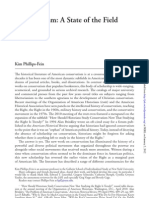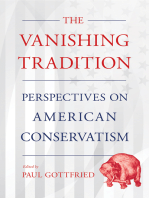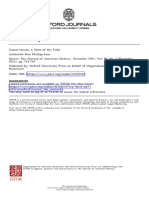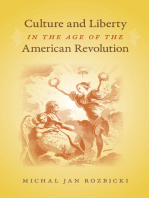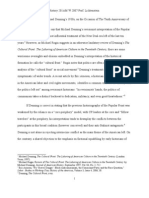405 Interview Nash
405 Interview Nash
Uploaded by
Clifford Angell BatesCopyright:
Available Formats
405 Interview Nash
405 Interview Nash
Uploaded by
Clifford Angell BatesOriginal Title
Copyright
Available Formats
Share this document
Did you find this document useful?
Is this content inappropriate?
Copyright:
Available Formats
405 Interview Nash
405 Interview Nash
Uploaded by
Clifford Angell BatesCopyright:
Available Formats
The Conservative Persuasion: An Interview with George H.
Nash Maxwell Goss is the editor of Right Reason, the weblog for philosophical conservatism. Suppose you wanted a better grasp on contemporary American conservative thought. Or suppose you were well acquainted with contemporary American conservative thought but were fuzzy about where it came from. Or suppose you understood where contemporary American conservative thought came from, but wanted to see how a historian with encyclopedic knowledge and a gift for elegant writing would weave its origins into a compelling narrative. Or suppose you were simply in the mood for a good book, a book that explored big ideas and interesting people and how they have interacted to shape history. You'd want to pick up a copy of The Conservative Intellectual Movement in America Since 1945, by intellectual historian George H. Nash. This book traces the rise of the post-war conservative movement from its unpromising origins to its current status as a force to be reckoned with. ISI books recently published an updated and revised 30th anniversary edition of this landmark book, and I took the occasion to interview its author for Right Reason. MG: Why did you choose to begin your history of American conservatism in 1945? GN: My book was originally a doctoral dissertation in History at Harvard University. While searching for a dissertation topic I had become interested in the role of intellectuals in American politics in the twentieth century. For a short time I worked on a dissertation about the Americans for Democratic Action (ADA), which was founded in 1947. I soon abandoned that topic and, with the encouragement of my adviser, decided to examine what was happening on the "right" side of the intellectual/political spectrum in that same period: the years immediately after World War II. It soon became apparent that the year 1945 was an appropriate point of departure for my investigation. There was no organized conservative intellectual presence in the United States at the end of World War II. Conservative voices here and there -- yes, but not what historians would consider a movement. I now had a story to research and tell: the story of the emergence of this movement or community from weakness and obscurity to power and influence in the new era known as the Cold War.
MG: Your book traces the development of three camps, three strands of thought, that coalesced into the post-war conservative movement: libertarians, traditionalists, and anti-communists. At first glance, these groups seem to have little in common. Can you say a bit about what brought them together? GN: You are quite right: in the beginning (the 1940s) there was not one rightwing renaissance in America but three, each reacting in diverse ways to a perceived challenge from the Left. No rigid barriers separated these groups, but they tended to act independently of one another. What gradually brought the three emerging components of the conservative revival together was a shared antipathy to twentieth century liberalism as well as a deepening sense of being under siege from the forces of leftism and liberal modernity. As these three independent wings of the conservative revolt against the Left became more self-conscious in the 1950s, many among them felt the need for greater intellectual coherence and for what we might call better networking. Here an event of enormous importance was the founding of National Review in 1955 by William F. Buckley, Jr. Apart from his extraordinary talents as a writer and polemicist, Buckley personified each impulse in the nascent coalition. He was at once a defender of the free market, a traditional Roman Catholic, and a staunch anticommunist (a source of his ecumenical appeal to conservatives). His magazine provided an indispensable forum for the multiplying voices of protest from the Right against liberal orthodoxy. Here was a place where conservatives of many stripes could seek and often find common ground. MG: You note that, through the 1950s, National Review, along with Russell Kirk's Modern Age, carried the ball in the task of defining the burgeoning conservative intellectual movement. But you go on to suggest that the decade closed with some uncertainty about the precise identity of conservatism: "What, if anything, bound these disparate people into one movement? What, in fact, was conservatism? What was conservatism in America?" How did conservatives try to answer these questions? Did they reach any consensus? GN: Conservatives in the late 1950s and early 1960s faced two huge challenges, one philosophical and one historical.
The philosophical challenge was this: amid all the sound and fury beginning to emerge on the intellectual Right, what was it that held them together? Behind what principles and aspirations could they coalesce? What did it mean to call themselves conservatives? What intellectual legitimacy did their movement have? This quest for philosophical self-definition took many forms: a revival of interest in Edmund Burke, for instance; in natural law teachings and the socalled Great Tradition of political philosophy; in the work of Eric Voegelin and Leo Strauss; in the classical liberalism of Hayek and others. The quest also exposed a growing and permanent tension between those who took the label libertarians and those who called themselves traditionalists. One result was a tremendous polemical controversy in the Sixties that became known as the freedom-versus-virtue debate, as the two sides tried to sort out their first principles. It fell to an ex-Communist and chief ideologist at National Review, a man named Frank Meyer, to formulate a middle way or modus vivendi that became known as fusionism -- that is, a "fusing" of the competing paradigms of those who favored freedom, and those who favored virtue (decent order), as the highest goods in a conservative society. It is a long story, but most conservatives eventually adopted fusionism as the proper and balanced expression of conservatism in the American context. And that leads me to the second high hurdle that self-identified conservatives had to overcome in this period: the insistence of their liberal critics that conservatism in America was illegitimate and inorganic -- at best a hothouse plant, at worst a form of social pathology or special pleading for social injustice. Time and again conservatives had to answer the liberal charge that America was fundamentally a liberal country and always had been. To refute this line of attack, conservatives evolved several strategies to show that the American experience, properly understood, did contain conservative elements, traditions, and institutions that were worth preserving and defending against those on the Left who would impose a dangerously utopian, statist, anti-traditional, irreligious new regime. Among other things, conservative intellectuals turned to the political philosophy of the Founding Fathers, the conservative dimension of the South, and the indigenous American traditions of limited government and entrepreneurial freedom for sustenance in their resistance to the Leftist assault.
With time, the "problem" of supposed conservative rootlessness and marginality tended to solve itself, as people who called themselves conservatives gained influence with the American "silent majority" during the cultural and political upheavals of the Sixties and later. How could one cavalierly dismiss conservatism as foreign to the American experience when self-avowed and increasingly self-confident conservatives began winning elections and shaping the agenda of public policy? This,of course, is just an synopsis of a complicated transformation that I explore in detail in my book. MG: In a later edition of your book, you mention a fourth strand of conservative thought: neo-conservatism. What did the neo-conservatives add to the mix? GN: Irving Kristol once said that a neoconservative is "a liberal who has been mugged by reality." In the late 1960s and 1970s many American liberals and social democrats had this experience and began an intellectual journey toward conservative positions. The stresses that produced this migration included disillusionment with the grandiose liberal social activism of the Sixties (the Great Society), alarm at the antinomian cultural upheavals of that era, and dismay at the rise of the New Left. Many neoconservatives were anticommunist liberals of the Harry Truman/Henry Jackson variety who found themselves bereft of a political home after the capture of the Democratic Party by the followers of George McGovern in 1972. Eventually, they made their way into the conservative coalition of Ronald Reagan. One consequence of this intellectual defection was, I think, profound. Since the days of the New Deal, American liberals had held a near monopoly on the manufacture and distribution of prestige among the intellectual and chattering classes. From the liberals' perspective, the libertarian, traditionalist, and Cold War conservatives of 1945-1965 or so were marginal figures -- no threat to liberalism's cultural hegemony and sense of superiority. The emerging neoconservatives, however, were an "enemy within" who had made their reputations while still on the Left and could not, therefore, be so easily dismissed. By publicly breaking with the Left and critiquing it so effectively, the neoconservatives undermined a hitherto unshakable assumption in liberal academic circles: the belief that only liberalism was an intellectually respectable point of view. This was a very significant development in the late
Sixties and 1970s. The neoconservatives helped to destroy the automatic equation of liberal sentiments with intelligence. The neoconservatives brought new respectability to the Right and greatly altered the terms of public debate in the United States. If you think of conservatism since World War II as an evolving coalition, the neoconservatives were the fourth component to arise. The fifth, I might add, was the Religious Right or social conservatives who mobilized in the Seventies and Eighties. This is something to bear in mind when you study the history of conservatism: It has not been static. MG: It seems to me that the quest for self-understanding might still be incomplete -- indeed, that conservatism, given its nature as a broad tradition rather than a crisp body of doctrine, must continuously work to define itself, both for its own sake and for those it would draw into its orbit. Who is performing this task today? Where might one look to find the conservative outlook being worked out in our time? GN: The conservative hero of the 1950s, the ex-Communist Whittaker Chambers, once said that "each age finds its own language for an eternal meaning." When you think about it, the vocation of the conservative is a never-ending task. The Spanish philosopher Ortega y Gasset remarked many years ago: "The simple process of preserving our present civilization is supremely complex, and demands incalculably subtle powers." That, in a nutshell, is what conservatism is all about -- if by "preservation" we also include the work of regeneration and renewal. So who is developing the conservative outlook today? In a sense we all are. Never in history have there been so many self-identified conservative voices as there are now, and never have they been more accessible. Consider all this from the perspective of a historian. When I began my doctoral dissertation a generation ago, the number of noteworthy conservative intellectuals in the United States was minuscule: a few dozen at most. Today how can we even begin to count? A veritable conservative counterculture -- a web of institutions from the Beltway to the blogosphere -- has been formed. This is an enormous change, and it occurred in the span of less than thirty years. In this respect it is an extraordinary time to be a conservative. The challenge today is not to find some obscure conservative Remnant out there but to find the time to keep up with the many fine voices in the conversation.
MG: It must be exciting, from a historian's perspective, to witness a real blossoming of conservative thought in our time. As exciting as this is, however, it is also hard not to notice the leftward drift of American politics and culture. Are the conservative voices getting through? GN: I do wonder about that sometimes. The mainstreaming of American conservatism in the past two generations has been a remarkable development. But as a historian I cannot but notice that during most of this same period American culture has been moving right AND left at the same time. Particularly in the area of "lifestyles," popular attitudes and mores have been veering in an increasingly permissive,even neopagan, direction. In my lectures around the country I often ask my audiences what -- apart from conservatism -- have been the most influential social and intellectual forces of the past thirty years or so. I tell them my own answer: feminism and environmentalism. Clearly the vectors of social change have not pointed in a uniformly conservative direction. This is not to say that conservatives should now succumb to cultural defeatism. Another phenomenon that I find historically significant is the rise in the past decade of what has been called a "missionary generation" of college and graduate students coming out of evangelical Protestant, conservative Roman Catholic, and Orthodox Jewish institutions of higher learning. If this "return to religion" persists, in fifteen or twenty years America might just be a more socially conservative country. Still, one of the "perils of prosperity" for today's self-conscious conservatives is that there now exists a conservative parallel universe. (The Left has one, too, and faces the same temptations.) Success can breed both triumphalism and sectarianism. So if I were to offer a bit of advice to conservatives who are trying to "get through" to the larger culture, I would say: Remember to address the real-world concerns of "everyday" people. And do not just talk to your own brethren. MG: If you could commend, say, three books to readers who wanted to understand American conservative thought, what would they be? GN: First, let me emphasize again that American conservatism is not, and has never been, univocal. It is a coalition with many components -- or, if you like,
a persuasion with many tendencies. I am not sure that you could find a consensus among either conservatives or historians of conservatism on a small list of indispensable "sacred texts." But we all have our favorites, and here are three of mine that have profoundly shaped my own understanding of modern American conservatism: Whittaker Chambers' autobiography WITNESS, Russell Kirk's THE CONSERVATIVE MIND, and Richard Weaver's IDEAS HAVE CONSEQUENCES. All were hugely important books in their time and are still resonant today. Now you might or might not agree with their arguments; you might even find the books dated in some respects. But taken together, they will challenge you philosophically. After reading them you will never look quite the same way on conservatism -- or on liberalism and leftist utopianism, either. MG: Thank you for making time for a Right Reason interview, Dr. Nash. Maxwell Goss recently received his doctorate in philosophy from the University of Texas at Austin. A glutton for punishment, he is now in law school. Mr. Goss is the editor of Right Reason, the weblog for philosophical conservatism.
You might also like
- Suburban Warriors: The Origins of the New American Right - Updated EditionFrom EverandSuburban Warriors: The Origins of the New American Right - Updated EditionNo ratings yet
- The Creation of the American Republic, 1776-1787From EverandThe Creation of the American Republic, 1776-1787Rating: 4 out of 5 stars4/5 (55)
- Donald Schon Design Studio Higher EducationDocument65 pagesDonald Schon Design Studio Higher EducationAline KerchNo ratings yet
- The Liberal Tradition in America: The Classic on the Causes and Effects of Liberal Thought in the U.S.From EverandThe Liberal Tradition in America: The Classic on the Causes and Effects of Liberal Thought in the U.S.Rating: 4 out of 5 stars4/5 (1)
- What Is Political Thought - A ReadingDocument14 pagesWhat Is Political Thought - A ReadingRamon Chito S. Pudelanan88% (8)
- Conservatism A State of FieldDocument21 pagesConservatism A State of Fieldcliodna18No ratings yet
- Ten Books That Shaped American Conservatism RenaissanceDocument32 pagesTen Books That Shaped American Conservatism Renaissancequintus14100% (2)
- The Neoconservatives: The Origins of a Movement: With a New Foreword, From Dissent to Political PowerFrom EverandThe Neoconservatives: The Origins of a Movement: With a New Foreword, From Dissent to Political PowerRating: 4 out of 5 stars4/5 (1)
- Phillips Fein ConservatismDocument21 pagesPhillips Fein ConservatismTalia ShabtayNo ratings yet
- PHILLIOPS-FEIN, Kim. Conservatism A State of The FieldDocument22 pagesPHILLIOPS-FEIN, Kim. Conservatism A State of The FieldRoarrrr100% (1)
- From Gramsci to Freud: 7 Anti Christian Philosophers Who Ruined AmericaFrom EverandFrom Gramsci to Freud: 7 Anti Christian Philosophers Who Ruined AmericaNo ratings yet
- The Debate Over Slavery: Antislavery and Proslavery Liberalism in Antebellum AmericaFrom EverandThe Debate Over Slavery: Antislavery and Proslavery Liberalism in Antebellum AmericaNo ratings yet
- Funding MovementDocument6 pagesFunding MovementMarikNo ratings yet
- ZolovDocument27 pagesZolovValeria ManzanoNo ratings yet
- BRANDON, High, 2009 - The Recent Historiography of American NeoconservatismDocument17 pagesBRANDON, High, 2009 - The Recent Historiography of American NeoconservatismMáh SouzaNo ratings yet
- The Idea of a Liberal Theory: A Critique and ReconstructionFrom EverandThe Idea of a Liberal Theory: A Critique and ReconstructionRating: 2 out of 5 stars2/5 (1)
- '"'Fhe Ubout 0ur: Ke Olution Li e : "Document13 pages'"'Fhe Ubout 0ur: Ke Olution Li e : "PerecNo ratings yet
- Outlines of Some Cultural Aspects of U.S. Imperialism: The Struggle for SocialismFrom EverandOutlines of Some Cultural Aspects of U.S. Imperialism: The Struggle for SocialismNo ratings yet
- For the People: American Populist Movements from the Revolution to the 1850sFrom EverandFor the People: American Populist Movements from the Revolution to the 1850sNo ratings yet
- Acts of Conscience: Christian Nonviolence and Modern American DemocracyFrom EverandActs of Conscience: Christian Nonviolence and Modern American DemocracyNo ratings yet
- David Montgomery Marxism and Utopianism in The USADocument6 pagesDavid Montgomery Marxism and Utopianism in The USAMaurizio AcerboNo ratings yet
- Schools of American HistoriographyDocument2 pagesSchools of American HistoriographyNinaNo ratings yet
- Radicals: Portraits of a Destructive PassionFrom EverandRadicals: Portraits of a Destructive PassionRating: 3.5 out of 5 stars3.5/5 (11)
- Booth - Hegemonic - Nationalism - Subordinate - Marxism - The - Mexican - Left - 19457Document28 pagesBooth - Hegemonic - Nationalism - Subordinate - Marxism - The - Mexican - Left - 19457narrehlNo ratings yet
- Fantasies of the New Class: Ideologies of Professionalism in Post-World War II American FictionFrom EverandFantasies of the New Class: Ideologies of Professionalism in Post-World War II American FictionNo ratings yet
- Plotting The Sixties 297136Document208 pagesPlotting The Sixties 297136Lobo Solitario100% (1)
- The Vanishing Tradition: Perspectives on American ConservatismFrom EverandThe Vanishing Tradition: Perspectives on American ConservatismRating: 4 out of 5 stars4/5 (4)
- PhillipsFein ConservatismStateField 2011Document22 pagesPhillipsFein ConservatismStateField 2011Federico PerelmuterNo ratings yet
- Liberalism Is Not Enough: Race and Poverty in Postwar Political ThoughtFrom EverandLiberalism Is Not Enough: Race and Poverty in Postwar Political ThoughtNo ratings yet
- Becoming International AgainDocument27 pagesBecoming International Againljunseo1007No ratings yet
- Samuel Francis, "Beyond Conservatism"Document5 pagesSamuel Francis, "Beyond Conservatism"Anonymous ZwwcxXNo ratings yet
- Massimo T.The New Left A Documentary History PDFDocument483 pagesMassimo T.The New Left A Documentary History PDFLatur1100% (3)
- Neil Hamilton - Dictionary of 1960s Counterculture in America (ABC-CLIO Companion)Document617 pagesNeil Hamilton - Dictionary of 1960s Counterculture in America (ABC-CLIO Companion)Giovanni Bello100% (3)
- Lynd - The New LeftDocument10 pagesLynd - The New LeftpopolovskyNo ratings yet
- Fowler FallConsensus 2021Document34 pagesFowler FallConsensus 2021sangbarto basuNo ratings yet
- Killing History The False Left-Right Political Spectrum and The Battle Between The Free Left and The Statist Left (L.K. Samuels (Samuels, L.K.) )Document773 pagesKilling History The False Left-Right Political Spectrum and The Battle Between The Free Left and The Statist Left (L.K. Samuels (Samuels, L.K.) )신지호No ratings yet
- Liberalism The History of A ParadoxDocument7 pagesLiberalism The History of A ParadoxThavam RatnaNo ratings yet
- The Victims of Democracy: Malcolm X and the Black RevolutionFrom EverandThe Victims of Democracy: Malcolm X and the Black RevolutionNo ratings yet
- Immanuel WallersteinDocument13 pagesImmanuel Wallersteinnarcis zarnescu100% (1)
- The Political Thought of William F. Buckley Jr.Document21 pagesThe Political Thought of William F. Buckley Jr.pp100% (1)
- To the Right: The Transformation of American ConservatismFrom EverandTo the Right: The Transformation of American ConservatismNo ratings yet
- The Development of A Revolutionary Mentality by Henry S.Document4 pagesThe Development of A Revolutionary Mentality by Henry S.Raphael FalcãoNo ratings yet
- Kuehnelt-Leddihn Liberalism in AmericaDocument7 pagesKuehnelt-Leddihn Liberalism in Americatinman2009100% (1)
- Culture and Liberty in the Age of the American RevolutionFrom EverandCulture and Liberty in the Age of the American RevolutionNo ratings yet
- Transcending Capitalism: Visions of a New Society in Modern American ThoughtFrom EverandTranscending Capitalism: Visions of a New Society in Modern American ThoughtNo ratings yet
- Rebellion or RevolutionDocument280 pagesRebellion or RevolutionMosi Ngozi (fka) james harris100% (3)
- Ken I. Kersch - Conservatives and The Constitution - Imagining Constitutional Restoration in The Heyday of American Liberalism - Libgen - LiDocument421 pagesKen I. Kersch - Conservatives and The Constitution - Imagining Constitutional Restoration in The Heyday of American Liberalism - Libgen - LiJulioErnestoHistoriaNo ratings yet
- What Is ConservatismDocument24 pagesWhat Is ConservatismarinaNo ratings yet
- Motherhood in Black and White: Ruth FeldsteinDocument25 pagesMotherhood in Black and White: Ruth FeldsteinDon RenNo ratings yet
- Liberalism and Its FriendsDocument5 pagesLiberalism and Its FriendsAnonymous hO3EBZJdxNo ratings yet
- The Politics of Cultural Despair: A Study in the Rise of the Germanic IdeologyFrom EverandThe Politics of Cultural Despair: A Study in the Rise of the Germanic IdeologyRating: 4 out of 5 stars4/5 (15)
- Artaraz - 2005 - El Ejercicio de PensarDocument19 pagesArtaraz - 2005 - El Ejercicio de PensarIgor MarquezineNo ratings yet
- DBQ - 1950s in AmericaDocument8 pagesDBQ - 1950s in Americaavinashpatel919264No ratings yet
- Review of Corey Robin's "The Reactionary Mind"Document15 pagesReview of Corey Robin's "The Reactionary Mind"Bruce MillerNo ratings yet
- Instant Access to The Radical Right 3rd Edition Daniel Bell (Editor) ebook Full ChaptersDocument81 pagesInstant Access to The Radical Right 3rd Edition Daniel Bell (Editor) ebook Full Chapterspelanlameezc100% (1)
- Reflections On Michael Denning's The Cultural Front and The New Popular Front HistoryDocument15 pagesReflections On Michael Denning's The Cultural Front and The New Popular Front Historykurtnewman100% (1)
- The Un-Codifiable in Any Constitutional Order: Clifford A. Bates Jr. Warsaw University (Osa, Iaie)Document8 pagesThe Un-Codifiable in Any Constitutional Order: Clifford A. Bates Jr. Warsaw University (Osa, Iaie)Clifford Angell BatesNo ratings yet
- Week 6 US Congress OverviewDocument12 pagesWeek 6 US Congress OverviewClifford Angell BatesNo ratings yet
- The Creation of The American Constitution: American Studies Center Warsaw UniversityDocument2 pagesThe Creation of The American Constitution: American Studies Center Warsaw UniversityClifford Angell BatesNo ratings yet
- Democracy in America Then and NowDocument3 pagesDemocracy in America Then and NowClifford Angell BatesNo ratings yet
- Bates RESEARCH METHODS in Political ScienceDocument2 pagesBates RESEARCH METHODS in Political ScienceClifford Angell BatesNo ratings yet
- Syllabus: American Studies Center Warsaw University Introduction To PoliticsDocument2 pagesSyllabus: American Studies Center Warsaw University Introduction To PoliticsClifford Angell BatesNo ratings yet
- Democracy in America Then and NowDocument3 pagesDemocracy in America Then and NowClifford Angell BatesNo ratings yet
- Blame It On HobbesDocument10 pagesBlame It On HobbesClifford Angell BatesNo ratings yet
- The Limits of International LawDocument272 pagesThe Limits of International LawClifford Angell Bates100% (2)
- Critical ThinkingDocument4 pagesCritical ThinkingClifford Angell BatesNo ratings yet
- The Marginalization of Aristotles PoliteDocument18 pagesThe Marginalization of Aristotles PoliteClifford Angell BatesNo ratings yet
- Peasants Pilgrims Sacred Promises PDFDocument229 pagesPeasants Pilgrims Sacred Promises PDFPakkaslapsiNo ratings yet
- Freedom's Basis in The IndeterminateDocument13 pagesFreedom's Basis in The IndeterminatecarlospaganoNo ratings yet
- Cube 1Document34 pagesCube 1api-373593354No ratings yet
- FCS 20210528 Not WebpageDocument19 pagesFCS 20210528 Not WebpageHemnath Patra দর্শনNo ratings yet
- Codes of Slav CulturesDocument40 pagesCodes of Slav Culturesplavi zec100% (2)
- Education Types of SchoolsDocument3 pagesEducation Types of SchoolsBoyko IgnevNo ratings yet
- PDF of Imtiaz Ahmed-DocumentDocument13 pagesPDF of Imtiaz Ahmed-DocumentTanya SinghNo ratings yet
- National Art As Legitimate Art - 'National' Between Tradition and Ideology in Ceausescu's Romania PDFDocument16 pagesNational Art As Legitimate Art - 'National' Between Tradition and Ideology in Ceausescu's Romania PDFSasho Blazes100% (1)
- Mit PDFDocument106 pagesMit PDFmaida nasir100% (1)
- The Scribal Life of Folktales in Medieval IndiaDocument19 pagesThe Scribal Life of Folktales in Medieval IndiaanjanaNo ratings yet
- Accomplishment ReportDocument27 pagesAccomplishment Reportmelanie concejaNo ratings yet
- Emulating VernacularDocument15 pagesEmulating VernacularBilly 'EnNo ratings yet
- Bendicion by Tato LavieraDocument377 pagesBendicion by Tato LavieraArte Público Press100% (4)
- Blaser - Ontological - Conflicts PDFDocument23 pagesBlaser - Ontological - Conflicts PDFpe lanaNo ratings yet
- Cultural Diversity Case StudyDocument4 pagesCultural Diversity Case Studyapi-19472001No ratings yet
- CAR Module 1Document38 pagesCAR Module 1Christian DenoraNo ratings yet
- Educ 475 ReflectionDocument2 pagesEduc 475 Reflectionapi-249683180No ratings yet
- 2013 - To and Fro. Modernism and Vernacular ArchitectureDocument246 pages2013 - To and Fro. Modernism and Vernacular ArchitecturesusanaNo ratings yet
- Applied Ethnomusicology and Intangible CDocument21 pagesApplied Ethnomusicology and Intangible CcatushNo ratings yet
- Ideas and Beliefs in Architectural and Industrial DesignsDocument559 pagesIdeas and Beliefs in Architectural and Industrial Designsbzanaj0% (1)
- Action Plan in EnglishDocument1 pageAction Plan in EnglishLanie Abaja FlorendoNo ratings yet
- Resume 2 Edited For WeeblyDocument5 pagesResume 2 Edited For Weeblyapi-240118598No ratings yet
- He Vlach Funeral Laments - Tradition RevisitedDocument24 pagesHe Vlach Funeral Laments - Tradition Revisitedwww.vlasi.org100% (1)
- Mso103 Block 1Document73 pagesMso103 Block 1Akram NongjaiNo ratings yet
- Jurisprudence Ass. 5th SemDocument21 pagesJurisprudence Ass. 5th SemanasNo ratings yet
- Turkish Post-Migrant "Opera" in Europe: A Socio-Historical Perspective On AuralityDocument23 pagesTurkish Post-Migrant "Opera" in Europe: A Socio-Historical Perspective On AuralitySinan Samanlı100% (1)
- Culture and Identity in AnthropologyDocument27 pagesCulture and Identity in AnthropologyTatoNo ratings yet
- Formation and Development of AxiolinguisticsDocument4 pagesFormation and Development of AxiolinguisticsresearchparksNo ratings yet









